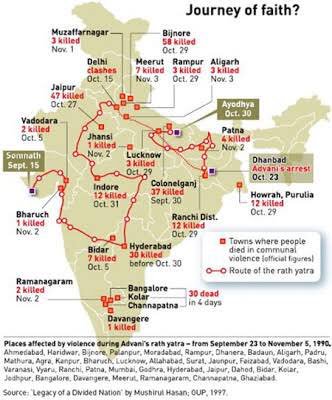How a Mystical Mutt of Yore Became HQ of Hardcore Hindutva Under Adityanath
Suhas Munshi | News18.comUpdated: March 4, 2017, 1:29 PM IST
BJP’s Gorakhpur MP Yogi Adityanath campaigns in Pilibhit on February 10. (PTI)
'Agla agna hogba to hey avadhu tu hova paani’If the person next to you is fire, then hey sadhu you should be water.
-Gorakh Vani
At about 1pm in Gorakhpur, Sunil Singh, the head of Hindu Yuva Vahini, was talking about Muslims he had murdered.
“Were you part of 2007 riots?”
“Haan... eint ka jawaab pathhar se diya… hamare ek bhai maroge, tumhare chaar bhai maarenge. Ek Musalmaan ne Dalit ladki ka balaatkaar kiya tha, jaan se maar diya tha. Mohan Munder village Kaptangunj mein, ek bhi Mussalman ka ghar nahi bacha. Sabke ghar jalaye. Theek se jalayee. Bum feke. Goliyan chalai. Do teen udhar se bhi mare.” (We gave them a fitting reply. If you kill one of us, we will kill four of you. A Muslim man raped a Dalit girl, killed her. In Mohan Munder village, not a single Muslim house was spared. All houses were burnt, bombed, fired at.”
For 25 years, Singh has been the head of Hindu Yuva Vahini, a private army of five-time Gorakhpaur MP Yogi Adityanath, who himself has been booked for making hate speeches, and was arrested during 2007 riots.
Standing in today’s poll-bound Gorakhpur, it’s difficult to believe that this city was once the spiritual headquarters of Nathpanthis, a tradition of mystics called kaan-phatas (because of their custom of piercing one ear), who trace their lineage to the Adiyogi, Lord Shiva. The Nath monks were known more for leading progressive and reformist movements across the subcontinent, which even inspired Kabir Das and Guru Nanak.
It
is difficult to believe today that Yogi Adityanath is the present
Mahant of the Mutt that was started by Dalits and made famous by
Muslims. Or that the Gorakhnath Mutt had little to do with Lord Ram or
heavy Hindutva.
Manoj Singh, a local journalist and a
scholar on Gorakhnath Mutt, offers a valid poser. “Ever since Adityanath
became the Mahant of this Mutt, I have not once heard a verse of Gorakh
Vaani from him,” he said. Nathpanthis had no connection with politics or even the wider society. They set up their centres well outside busy settlements to spend time alone meditating.
And then came the turn of his disciple Avaidyanath who represents Gorakhpur in the Lok Sabha.
While the ambitions of his predecessors were confined to Gorakhpur, Adityanath wants to play on a national stage. He has addressed 150 rallies in UP campaign, and is threatening to overshadow all other BJP leaders in and outside UP.
‘Habak na chalba, thabak na chalba, dheere dharba paon,’ goes a line of Gorakh Vaani. (Do not walk fast or jump, O selfless Sadhu, place your feet slowly.)
Adityanath has emerged as BJP’s power-centre in Poorvanchal. Since he jumped into electoral politics, in 1989, the party has maintained dominance over the area’s MLAs, city mayors, and Parliamentary seat.
On the other hand, though, he has not really achieved much outside Gorakhpur. In the 41 Assembly seats in the Gorakhpur–Basti belt under his leadership, the party has never secured more than 11 seats. This shows how, in this belt, which has a high percentage of Dalits, Adityanath has been popular only among few upper caste Hindu voters.
This
time, the BJP’s prospects even within Gorakhpur look grim. Nishads,
with about 1 lakh voters, have formed their own party. Kayasths have
publicly supported the BSP, strong renegade BJP leaders are threatening
to take down new BJP candidates in Gorakhpur district.
“The party is in such a bad shape that for the first time its party president has had to hold rallies here,” said Sunil Singh.Being such a popular and powerful figure in his district, Yogi Adityanath holds a darbar outside his office in Gorakhpur Mutt every morning. Those whose voices aren’t heard by bureaucrats and police start assembling outside his office from 7am to seek an audience with him.
The venue of Yogi Adityanath's morning darbar.
On March 2, Adityanath was uncharacteristically late in his durbar. According to his assistants, Yogi Adityanath was busy meeting and talking to people on phone since 5 in the morning. Later in the day, he’d go and receive Amit Shah and hold a joint roadshow with him.
Adityanath arrived with his assistants only at 9. Media, eagerly waiting for a sound byte on the last day of campaigning in phase six, was lined up. Many wanted to get his views on the local newspaper advertisements that BJP had published that morning. It had Amit Shah’s face on it, not Adityanath’s. BJP had clearly shown the Mahant his place.
Unlike his usual practice of sitting on his customary chair, he stopped outside his office for a second — listening to his audience — and dismissed everyone immediately. “Chunaav ke baad aana,” he said while walking away from the people holding requests and recommendation letters in their hands.
Yogi Adityanath has achieved quite a lot at a remarkably young age of 44. But this time, he is fighting one of the toughest battles of his political life. On one hand, political parties like the BSP and the SP–Congress alliance threaten to invade into his political space. And on the other, disadvantaged communities like Nishads are for the first time fighting back to stake their claim on the Mutt, since, they claim, Gorakhnath’s guru Matsyendranath was a Nishad.
At this time, it may be wise for the Yogi to return to the timeless, memorable and instructive verses of Gorakh Vani.
‘Ye jag hai kaanto ki badhi, dekh dekh pag dharna,’ (This world is full of thorns, O Sadhu, tread very carefully.)


